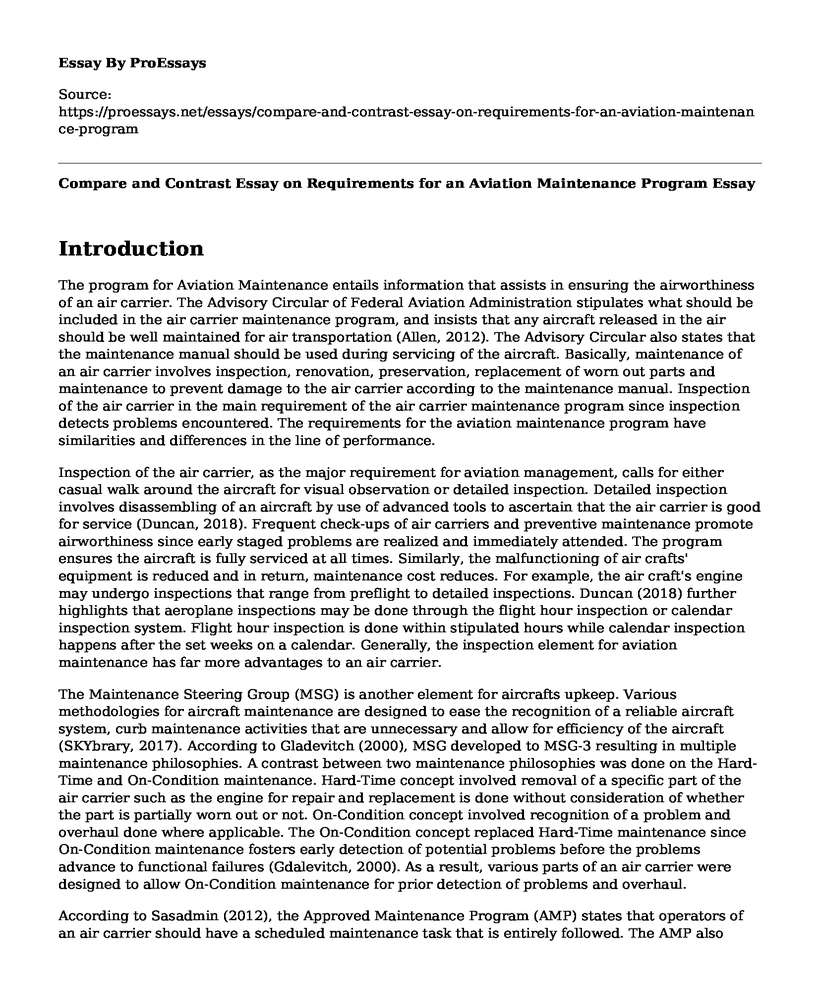Introduction
The program for Aviation Maintenance entails information that assists in ensuring the airworthiness of an air carrier. The Advisory Circular of Federal Aviation Administration stipulates what should be included in the air carrier maintenance program, and insists that any aircraft released in the air should be well maintained for air transportation (Allen, 2012). The Advisory Circular also states that the maintenance manual should be used during servicing of the aircraft. Basically, maintenance of an air carrier involves inspection, renovation, preservation, replacement of worn out parts and maintenance to prevent damage to the air carrier according to the maintenance manual. Inspection of the air carrier in the main requirement of the air carrier maintenance program since inspection detects problems encountered. The requirements for the aviation maintenance program have similarities and differences in the line of performance.
Inspection of the air carrier, as the major requirement for aviation management, calls for either casual walk around the aircraft for visual observation or detailed inspection. Detailed inspection involves disassembling of an aircraft by use of advanced tools to ascertain that the air carrier is good for service (Duncan, 2018). Frequent check-ups of air carriers and preventive maintenance promote airworthiness since early staged problems are realized and immediately attended. The program ensures the aircraft is fully serviced at all times. Similarly, the malfunctioning of air crafts' equipment is reduced and in return, maintenance cost reduces. For example, the air craft's engine may undergo inspections that range from preflight to detailed inspections. Duncan (2018) further highlights that aeroplane inspections may be done through the flight hour inspection or calendar inspection system. Flight hour inspection is done within stipulated hours while calendar inspection happens after the set weeks on a calendar. Generally, the inspection element for aviation maintenance has far more advantages to an air carrier.
The Maintenance Steering Group (MSG) is another element for aircrafts upkeep. Various methodologies for aircraft maintenance are designed to ease the recognition of a reliable aircraft system, curb maintenance activities that are unnecessary and allow for efficiency of the aircraft (SKYbrary, 2017). According to Gladevitch (2000), MSG developed to MSG-3 resulting in multiple maintenance philosophies. A contrast between two maintenance philosophies was done on the Hard-Time and On-Condition maintenance. Hard-Time concept involved removal of a specific part of the air carrier such as the engine for repair and replacement is done without consideration of whether the part is partially worn out or not. On-Condition concept involved recognition of a problem and overhaul done where applicable. The On-Condition concept replaced Hard-Time maintenance since On-Condition maintenance fosters early detection of potential problems before the problems advance to functional failures (Gdalevitch, 2000). As a result, various parts of an air carrier were designed to allow On-Condition maintenance for prior detection of problems and overhaul.
According to Sasadmin (2012), the Approved Maintenance Program (AMP) states that operators of an air carrier should have a scheduled maintenance task that is entirely followed. The AMP also provides rules for the operators to use and the criteria by which tasks are to be performed. The Maintenance Planning Document (MPD) contains information on maintenance planning that allows every operator to also decide on which maintenance task is necessary, and how it should be done (Sasadmin, 2012). However, during Airworthiness Limitations (AL), the operators strictly follow instructions in the maintenance program to the latter to curb problems with certain operating systems.
Conclusion
In conclusion, the maintenance of an aircraft is termed essential and paramount to ensure that the aircraft is fit for transportation and able to offer long-term service. In relation to the maintenance program, most of the requirements for maintenance of the plane allow operators to use personal skills and experience to service the aircraft, unless when a critical problem arises. For example, the Maintenance Planning Document and Advisory Circular have maintenance requirements that allow operators to also incorporate their own maintenance program. However, some maintenance programs such as the ON- Condition maintenance is to be strictly used for ideal maintenance of the aircraft. Similarly, frequent inspection of the aircraft is a mandatory requirement in the maintenance program to reduce maintenance cost and ensure long service of the aircraft.
References
Allen, J. M. (2012). Air Carrier Maintenance Programs. Advisory Circular.
Duncan, J. S. (2018). Aviation Maintenance Technician Handbook-General. Oklahoma: The U.S. Department of Transportation, Federal Aviation Administration, Airmen Testing Standards Branch.
Gdalevitch, M. (2000). MSG-3, The Intelligent Maintenance. Aviation Pros.
Sasadmin. (2012). Approved Maintenance Program (AMP). SOFEMA Aviation Services.
SKYbrary. (2017). Maintenance Steering Group-3 (MSG-3). Flight Safety Foundation.
Cite this page
Compare and Contrast Essay on Requirements for an Aviation Maintenance Program. (2022, May 16). Retrieved from https://proessays.net/essays/compare-and-contrast-essay-on-requirements-for-an-aviation-maintenance-program
If you are the original author of this essay and no longer wish to have it published on the ProEssays website, please click below to request its removal:
- Case Study Example: Problems in the U.S. Airline Industry
- Report Example on Lufthansa Airlines - Company Overview
- Paper Example on Aircraft Cockpit: Evolution Over Time
- 96% of Air Crashes in 2014: The Unsatisfactory Reality - Essay Sample
- Explore the World of Biomechanics: From Human Movements to Plant Cells
- Child Obesity: A Growing Health Issue Affecting Nations.
- Delta Airlines SWOT Analysis: Achieving Leadership in Air Transport - Essay Sample







